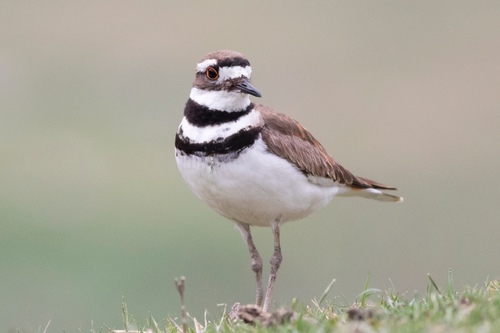
Killdeer
The Killdeer (Charadrius vociferus) is a medium-sized plover found throughout the Americas. It is known for its distinctive, loud call, from which it gets its name, and its characteristic "broken-wing" display used to distract predators from its nest. Unlike many shorebirds, Killdeer are often found far from water, inhabiting open habitats like fields, pastures, and even parking lots. They play an important ecological role as insectivores, helping to control populations of various invertebrates. While not typically considered culturally significant in the same way as some larger birds, their ubiquity and distinctive behavior have made them a familiar sight and sound to many.
20-28 cm
Length
45-60 cm
Wingspan
Least Concern
Conservation Status
Distribution
The Killdeer's range extends from southern Alaska and Canada, across the United States, and down through Mexico, Central America, and parts of South America, including the Caribbean. They are migratory in the northern parts of their range, moving south for the winter. Altitudinally, they can be found from sea level to high-elevation grasslands.
Lifespan
Up to 10 years in the wild, although average lifespan is likely shorter.
Killdeer's Habitat
Habitat Types
Grasslands, Fields, Pastures, Mudflats, Shorelines, Gravel bars, Golf courses, Airports
Climate Zones
Temperate, Subtropical, Tropical
Adaptations
Killdeer are well-adapted to open habitats. Their relatively long legs allow them to run quickly across the ground, and their countershaded plumage (dark above, light below) provides camouflage in open areas. They are highly adaptable and can tolerate human-modified landscapes.
Variations
Several subspecies are recognized, differing slightly in size and plumage coloration. For example, *C. v. ternominatus* is found in the Bahamas and Greater Antilles, and *C. v. peruvianus* is found in Peru and Chile.
Appearance
Breeding Plumage
Plumage is generally similar year-round, though breeding birds may have slightly brighter colors.
Seasonal Feather Changes
Minimal seasonal variation.
Sex Based Plumage Differences
Males and females have very similar plumage.
Notable Features
Two black breast bands, Brown back and wings, White belly, Orange-rufous rump visible in flight, Red eye-ring
Diet and Feeding
Primary Foods
Insects, Spiders, Earthworms, Snails, Other invertebrates, Occasionally small seeds
Foraging Behavior
Killdeer primarily forage by running, stopping, and then pecking at the ground. They often use a foot-trembling technique to stir up prey in shallow water or mud.
Specializations
Their relatively long bill is well-suited for probing in soft substrates. Their visual acuity is also important for spotting prey.
Seasonal Diet Variations
Diet composition may shift slightly depending on prey availability, with a greater reliance on insects during the breeding season.
Behavior
Social Structure
Killdeer are generally solitary or found in pairs during the breeding season. Outside of the breeding season, they may form small, loose flocks.
Communication
Loud, piercing "kill-deer" call, Rapid series of notes during courtship, Alarm calls given when predators are near, Broken-wing display to distract predators
Migration
Northern populations are migratory, moving south for the winter. Migration routes are variable, and some populations may be resident year-round.
Territorial or Group Behaviors
Killdeer are territorial during the breeding season, defending their nesting area from other Killdeer and potential predators. The "broken-wing" display is a classic example of territorial defense, where the bird feigns injury to lure predators away from the nest or chicks.
Conservation
Threats
Habitat loss and degradation, Pesticide use, Collisions with vehicles, Human disturbance
Protection Programs
Migratory Bird Treaty Act (in the US), Species at Risk Act (in Canada), Habitat conservation efforts by various organizations
Local National Laws
Protected under various state and provincial laws.
Population Trend
Stable
Population Estimates
Global population estimated to be around 1-2 million birds.
Interesting Facts
Killdeer are known for their "broken-wing" display.
This distraction display is used to lure predators away from the nest or chicks. The bird will run away from the nest, dragging one or both wings as if injured, and making distress calls.
They often nest in seemingly unsuitable locations.
Killdeer have been known to nest on gravel rooftops, in parking lots, and other human-altered habitats. This can make them vulnerable to disturbance and nest destruction.
Killdeer chicks are precocial.
This means they are relatively mobile and independent soon after hatching, able to walk and forage with minimal parental assistance.
Killdeer have been observed using tools.
There are a few documented observations that suggest Killdeer use pieces of bread or insects as bait to lure fish closer.
Faqs about Killdeer
What should I do if I find a Killdeer nest?
Leave it undisturbed. Killdeer are protected by law, and it is illegal to harm them or their nests. Observe from a distance and avoid approaching too closely.
Why is a Killdeer doing a "broken-wing" display?
It is likely trying to distract you from its nest or chicks. Move away from the area, and the bird should stop the display.
Do Killdeer migrate?
Yes, northern populations migrate south for the winter. Southern populations may be resident year-round.
What do Killdeer eat?
They primarily eat insects and other invertebrates, which they find by probing in the ground or picking from the surface.
Copyright @ Nature Style Limited. All Rights Reserved.
 English
English